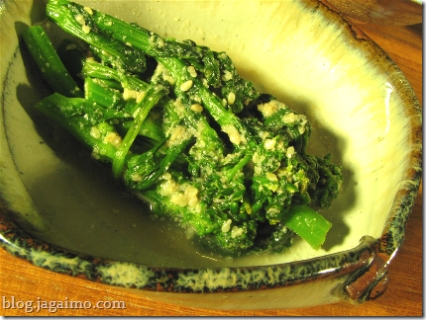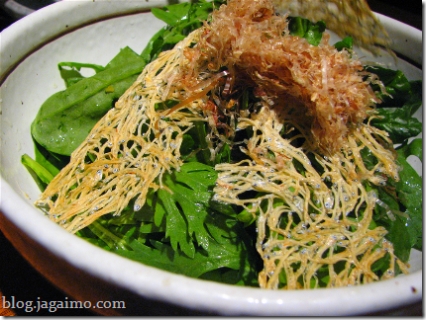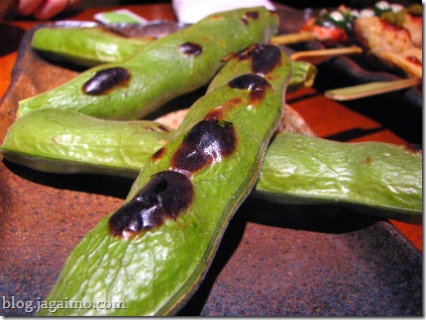Occasionally I've suggested that yu tsai or yu choi can stand in for nanohana, the greens of the rapeseed plant that are widely available in Japan during the springtime.
In fact, though, rapini, also called broccoli rabe, is far more like nanohana than yu choi is, at least in terms of flavor and appearance. Both rapini and nanohana are generally fairly bitter, and both respond well to blanching.
Although the standard rapini treatment in the US seems to involve sauteeing with garlic and olive oil, the bitterness of rapini mellows out considerably after being blanched for about a minute in acidulated, salted walter, then shocked in ice water. So much, in fact, that such rapini actually seems quite mild in comparison to similarly prepared nanohana.
Tonight I decided to take advantage of rapini for two dishes... one is a simple suimono, or clear soup, and the other is aemono, a simply dressed side dish.
Rapini to Shimeji no suimono
For the soup, I prepared my usual konbu-porcini stock and seasoned it with salt, light-color soy sauce (usuguchi shouyu), a bit of sake, and a bit of sugar. This time, I added a tiny bit of katakuriko to give the soup a little body. After tasting the stock, I added some shimeji mushrooms and let them simmer a bit; just a minute or so before serving, I added the blanched rapini to warm it up before serving.

Rapini no Goma-ae
For a cold side dish, I toasted white sesame seeds in a dry pan before grinding them up. I combined the ground sesame with a bit of sugar and salt, added some water and a tiny bit of soy sauce, and briefly boiled the paste to thicken it slightly. Though it's certainly not the standard choice, I added a bit of a syrupy-thick aged balsamic vinegar at the tail end, which adds a hint of complexity that ordinary rice vinegar wouldn't provide. Since the blanching water was slightly acidic from rice vinegar, I also didn't need much vinegar in the gomadare (sesame sauce).
The sauce is simply tossed with the blanched rapini and served in a small bowl.

In the US, outside of aromatics like onions and garlic, we often seem to try to avoid serving the same vegetable in two different dishes at the same meal. However, in Japan, I found it was fairly common to do so, especially when something was particularly plentiful and in season.
For American and European cooking, we often serve such large portions that it would become tedious to eat too much of the same ingredient. However, the smaller portions in Japanese cooking make it worth considering, especially if you can think of an interesting textural or flavor contrast for a particular item. In this case, one dish is served hot, and the other cold. One is soupy and mild, and one is slighly salty and has a strong flavor from the sesame sauce.
Both bring out something different in the rapini.
I remember a small Kyoto restaurant run by an interesting obaachan I visited almost 4 years ago... Unprompted, she served a hot variaton of a vegetable side dish my friend and I had previously ordered cold, just to demonstrate that greens can be completely transformed with a slight adjustment in preparation.
Whenever I'm faced with a surplus of a particular ingredient, recalling that moment helps me realize that only a small touch of creative energy can make something familiar and boring into something new and compelling all over again...



















